 Torre Quarta Alta (with climbers at the top) and Torre Quarta Bassa (slanting)
Torre Quarta Alta (with climbers at the top) and Torre Quarta Bassa (slanting)Torre Quarta Alta (with climbers at the top) and Torre Quarta Bassa (slanting). Patrick pointing the way.
Dolomites — allegedly one of the best trad-climbing venues in Europe. A meet by Bowline Climbing Club was held there in the end of this summer. I had a chance to participate it for a few days, then further climbed on after the meet, with another visiting friend of mine.
It was most heart-warming to be reunited with my good old friends of the BCC. And the overall experience was priceless!
Ascent of Spigolo Jori, Punta Fiames

Shot of Punta Fiames during the approach. The red solid line indicates Spigolo Jori. The approach (green, dashed) involves climbing with the UIAA grades up to III, and is followed by the first 4 pitches of Via Dimai for 150m with the grades up to IV- (orange). ©Masa Sakano, All rights reserved.
The highlight of this trip for 2 weeks was the ascent of Spigolo Jori (or Fiames Arete), Punta Fiames. The route climbs a soaring south-facing arete clearly visible from Cortina d'Ampezzo, where we camped, as some of souvenir postcards of Cortina show. It is 500-metres long for 14-pitches with the grade up to UIAA V+, and tops out to the summit, as the best mountaineering routes should be. Among the 14 pitches, 4 long pitches were V- or above, and most of the rest, but a pitch and a 100-m traverse early in the route, are IV- or above. In short, it is a pretty sustained route for the grade.
Michelle was keen and interested me in the route. The grade V+ seems to be British Very Severe (VS) at most. Michelle had bagged many VSs, but to lead long multi-pitch at VS in a committed situation was probably pushing, so I was expected to take those harder pitches, whereas easier pitches would be lead alternatively. I willingly bought it, and so did Tony and Simon P.
The following day we left the road at 7:45am under the perfect weather. What wasn't perfect was our navigation. To cut the long story short, we failed to make to even the start of the climb.
When we believed we started climbing P1, it was in fact still a part of the approach. Michelle and I climbed 3 pitches from there, going well off-route and topping out to a local highest point there, where we could clearly see a party on Punta Fiames South Face 100 or so metres ahead. We abseiled down for 60 metres from there to the other side and then joined Tony and Simon, who had already retreated from the first pitch after us, realising something wasn't right.
Why did it go wrong?
A group dynamics worked in a bad way. Every one thought other people
must know where to go, while in reality no one did.
I was the worst.
I had made pretty much zero homework and was practically a passenger, as far as the navigation is concerned.
When Michelle pointed out the route from our high point, I could not figure out where she was pointing, before she said
Can you see the fucking arete there? It is called "Fiames Arete"!
By that time it was after midday and so was too late to commit to the route. We had no choice but walked back down. Obviously we were tired, but the route looked too good to give up. The forecast for the following day was also good.
 Before starting the climb
Before starting the climbThe team geared up, before starting the climb.
So back went we next morning, leaving the road at 6am this time. And we finally started climbing the first pitch at 9am, as 2 teams of 2; Tony and Simon went first, and then Michelle and I followed, starting from my lead.
Shortly after 11am, we were at the start of the arete proper, after 250m of climbing, where climbing becomes harder. Indeed even the opening moves of the initial pitch (IV) turned out to be hard! It was perhaps British-tech 4c, although IV should correspond to Mild-Severe. In the original plan it was Michelle's turn to lead for us two. However, having seen an effort by Simon and Tony to get up there, she let me lead it.
She later confessed she was glad at her decision, after she had climbed it seconding and had confirmed its difficulty. She appeared to be a little disappointed, too, as if it had been a failure. I have no doubt she could have lead it cleanly, but might have taken time. Given it is a long mountain route, she made the right decision; I am sure she knew that, but I do understand such a feeling as a climber.
The rest of the routes were pleasantly and continuously hard and interestingness was very sustained. It was almost never easy until pretty much the last move to top out to the summit. It was an absolutely fantastic route!
 Tony on the slab on the crux P11 of Spigolo Jori, Punta Fiames, Dolomites
Tony on the slab on the crux P11 of Spigolo Jori, Punta Fiames, DolomitesTony on the slab in the crux P11.
 Tony on the crux P11 of Spigolo Jori, Punta Fiames, Dolomites
Tony on the crux P11 of Spigolo Jori, Punta Fiames, DolomitesTony high on the crux P11, belayed from an exposed narrow ledge.
 Michelle on the P10 belay of Spigolo Jori, Punta Fiames over Cortina d'Ampezzo
Michelle on the P10 belay of Spigolo Jori, Punta Fiames over Cortina d'AmpezzoMichelle about to start seconding P11. Cortina d'Ampezzo distant below.
We topped out at 19:20 with the sunset fast approaching. In other words, it took 2 hours to do the first 250m (5 pitches) and then 8 hours for the other 250m (9-10 pitches). It was 15 hours activity from carpark to carpark.
The weather was gorgeous all day, and the scenery was stunning. As we climbed as 2 teams of 2, it was very social, too. At times there were 3 people on the same belay ledge, unlike lonely climbing by a party of 2. It might well be my best rock-climbing day!
 Tony and Michelle at P7 belay
Tony and Michelle at P7 belayTony and Michelle at P7 belay.
 Simon about to set off P10
Simon about to set off P10Simon about to set off for P10.
 Sunset shot from Punta Fiames
Sunset shot from Punta FiamesSunset view, after successfully completing our climb of Spigolo Jori.
Afterthought of Spigolo Jori
One thing we made right in climbing Spigolo Jori (on the second attempt) was to leave early. It took considerably longer than we had anticipated, but we finished climbing before the sunset if only just, and descended mostly torch-free except for the last stretch.
 Simon on the last pitch (P14) of Spigolo Jori, Punta Fiames, Dolomites
Simon on the last pitch (P14) of Spigolo Jori, Punta Fiames, DolomitesSimon on the last pitch of Spigolo Jori (or the penultimate pitch in standard pitching; we did the last 2 pitches in one go, as described in the RockFax guidebook and we regretted it later).
To be fair the climbing was a little harder than our expectation. A couple of pitches were more like HVS to second, rather than HS, or VS at most, as guessed from the grade conversion.
Also, we wasted 1 hour at the start to work out the true starting point of the climb, after we had arrived somewhere very close. It was majorly because the new RockFax guide we used primarily was wrong (surprise, surprise) in both the description and photo topo for that point. Similarly, P13 was given neither grade nor length in the RockFax guide. We assumed it would be ungradably easy, but as we climbed we found it was more spicy, actually 30m of IV/- in other guidebooks, as found later.
I later made some research for various routes, using other 4(!) guidebooks, and found most descriptions in the new RockFax guide were simply taken from other previously-published guides. That means RockFax copied even wrong descriptions, as they were. I know some were wrong because I climbed those routes during my stay. Given the RockFax guide was by far the newest among 5 guidebooks we had, it may deserve a criticism to be lazy.
RockFax guide appears to be the most modern and clearest, thanks to its photo topo, but in effect clarity wasn't always the case. Detailed drawn topo with the rock features described, as seen in other guidebooks, is often more helpful, particularly for long multi-pitch routes, because the rock you actually see at 10 pitches up on a route is rather different from a photo taken from a completely different angle from a distance. Worse, when the line on the photo topo is wrong, as we spotted, nothing would compensate.
Having all said that, the number of guidebooks and resources of Dolomites in English is very limited. In that sense, there is not much alternative for us, unfortunately. So, we should just take it with a pinch of salt, or better, get a local guide (and learn Italian!?).
By the way we were not the slowest party. After we came back to the road at 9pm, we saw some head-torch lights on the south face of Punta Fiames, from which it would take at least 2 hours just to descend. In another case, a pair of 2 climbers I met in the campsite later climbed Spigolo Jori and they took 17 hours from car to car. They must have climbed the last few pitches in dark (indeed one of them said to me he had found the penultimate pitch was hard). It is a big route and should not be underestimated!
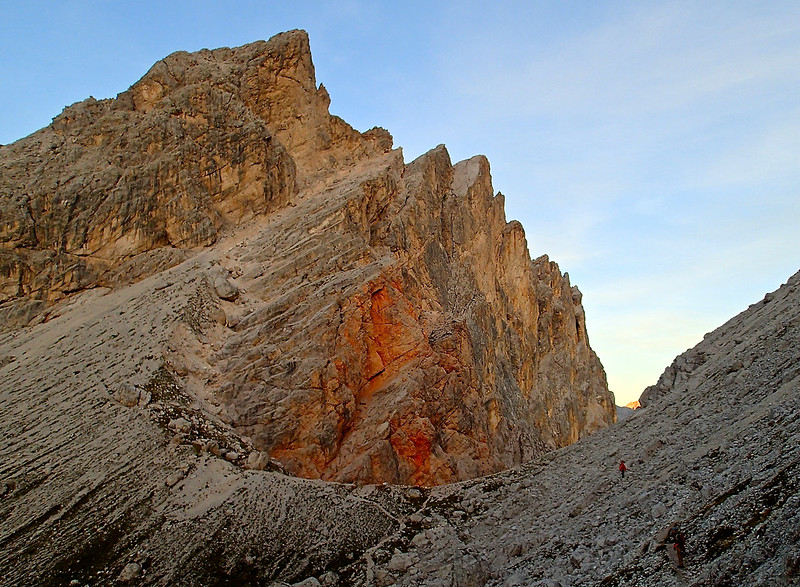 Tony walking towards the col in sunset
Tony walking towards the col in sunsetDescending to the col from Punta Fiames.
Cinque Torri and other ascents
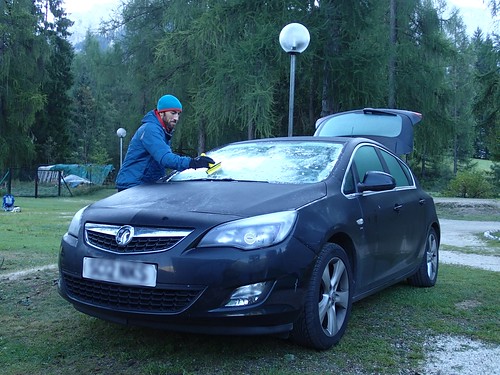 Cold start in the morning
Cold start in the morningScraping ice off the front screen of the car in the morning in the campsite.
In Dolomites I heard Tre Cime was a great, if serious, mountain. I set my eyes on it. But unfortunately the weather turned against me. After we climbed Spigolo Jori in T-shirts all day, it cooled down and eventually it started raining. A few days later it snowed down to the altitude of 2000 metres. Even at the campsite in the valley the temperature dropped to freezing at night. High mountain routes like Tre Cime were clearly out.
Instead I spent 5 days in Cinque Torri (meaning "5 Towers" in English). It is relatively low in altitude, very accessible and has fantastic rock features, as well as historic significance (of the WWI). All the towers there have no other mean to get to the top but climbing for 100 or so metres (though some are equipped with via ferrata). Then only the descent is either to climb down or more conventionally to abseil down. To climb up a vertical tower is akin to mountaineering!
However, in the end I wasn't very impressed with trad climbing in Cinque Torri. Easier routes (at the grade of UIAA V or below) are well polished, as well as are often congested. Harder routes have far less polish, but instead have an excessive amount of pegs and even bolts, where the climbing gets hard. I found Armida (VI) and Finlandia (VI+) there would be good E2 and E3/E4, respectively, without pegs/bolts. But in reality they are basically clip-up in hard sections and so are not quite a trad route.
That was to me quite disappointing, and so I have no desire to go back there.
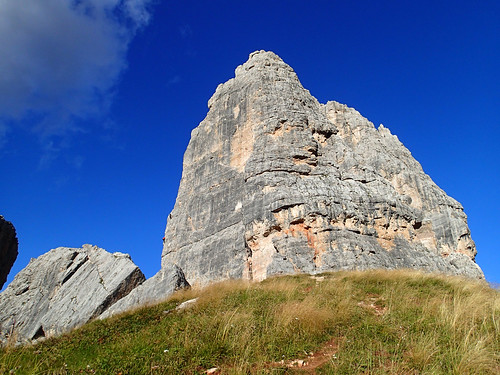 Torre Grande – Cima Ovest, Cinque Torri
Torre Grande – Cima Ovest, Cinque TorriTorre Grande – Cima Ovest, Cinque Torri.
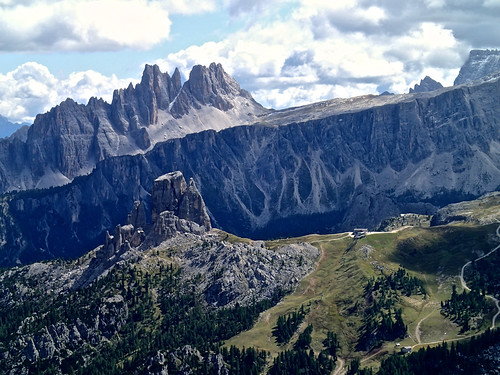 Croda da Lago beyond Cinque Torri
Croda da Lago beyond Cinque TorriCroda da Lago beyond Cinque Torri.
On the other hand, mountain routes in Dolomites seem to be cleaner. My Scottish friend Patrick and I climbed on my last day Dibona on Torre Grande di Falzarego (Falzarego Tower), a 300m mountain route (up to V+). It is true there are more fixed gear on route than I would wish, however it is certainly cleaner than the routes in popular Cinque Torri and is similar to Spigolo Jori. Or, perhaps because it is longer, the fixed gear is inevitably spaced?
Whichever, proper mountain routes seem to be the way to enjoy Dolomites for trad climbers. There is no shortage of them, such as, Tre Cime, Marmolada and Sasso delle Nove (which is famous for Messner's exploration)!
 Falzarego Towers from the carpark at Ristorante Strobel
Falzarego Towers from the carpark at Ristorante StrobelFalzarego Towers.
Bowline CC Meet
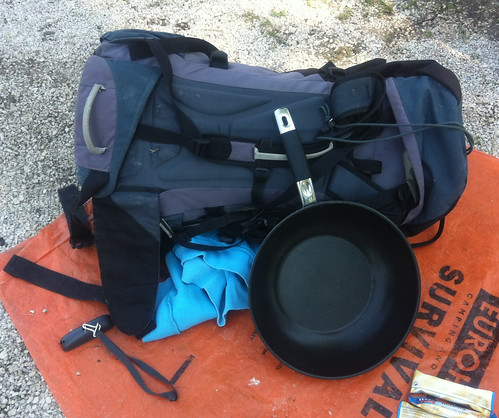 Michelle's hand luggage
Michelle's hand luggageMichelle's hand luggage in air travel. Well done!
A good thing to participate a meet by the Bowline CC is it is very social with good friends. What I was most impressed with was Michelle had brought a medium-size wok in her hand-luggage over flight. Together with a set of proper cutlery Tony brought and great culinary skill by Michelle, the group evening meals were most enjoyable! I didn't expect to have risotto properly cooked from scratch on camping stove!
Also, there was a nice and additional surprise. After all the 6 members of the Bowline left Cortina, Dolomites, I was left alone in the campsite, waiting for Patrick's arrival for 36 hours. Then at night in the campsite, out of the blue I was greeted by another Bowline member, Chris, who was travelling in the continent by motorbike from England and turned up there. We then had a good walk the following day under a very nice weather (before the rain would arrive the day after), and then in the evening joined another Bowline member Rob Pullen and his friends, who travelled separately, again unknown to me till the day, in Cortina town. It was very nice to see my old friends for one after another, thousands of miles away from Britain. It was a pleasant surprise, and I appreciate this meet was organised by Bowline CC!
(by Masa Sakano, 2015-09-21)
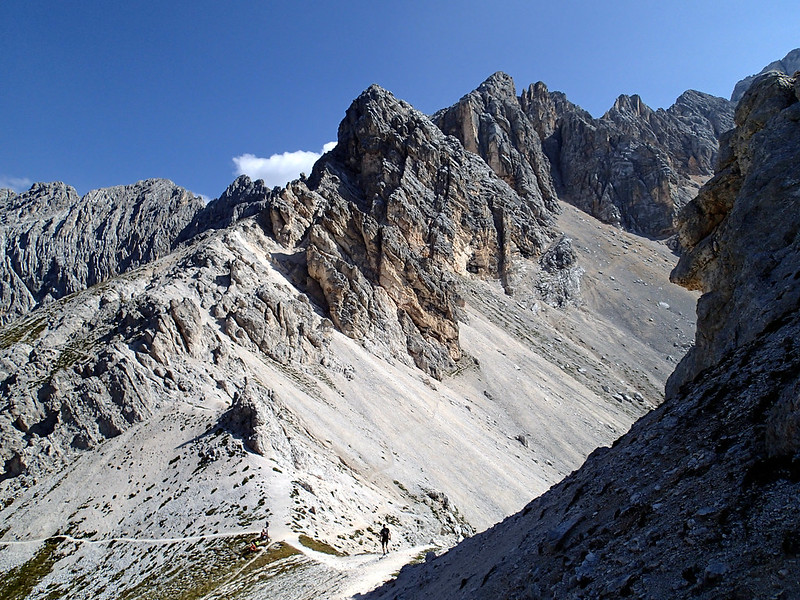 Walking in Dolomites
Walking in DolomitesChris walking down to a col in Dolomites.
The license of all the photos are Creative Commons Attribution-Share Alike 2.0 Generic (CC BY-SA 2.0) unless stated otherwise, with the copyright held by Masa Sakano. Some other photos are available at Masa's Flickr page.



コメントを追加